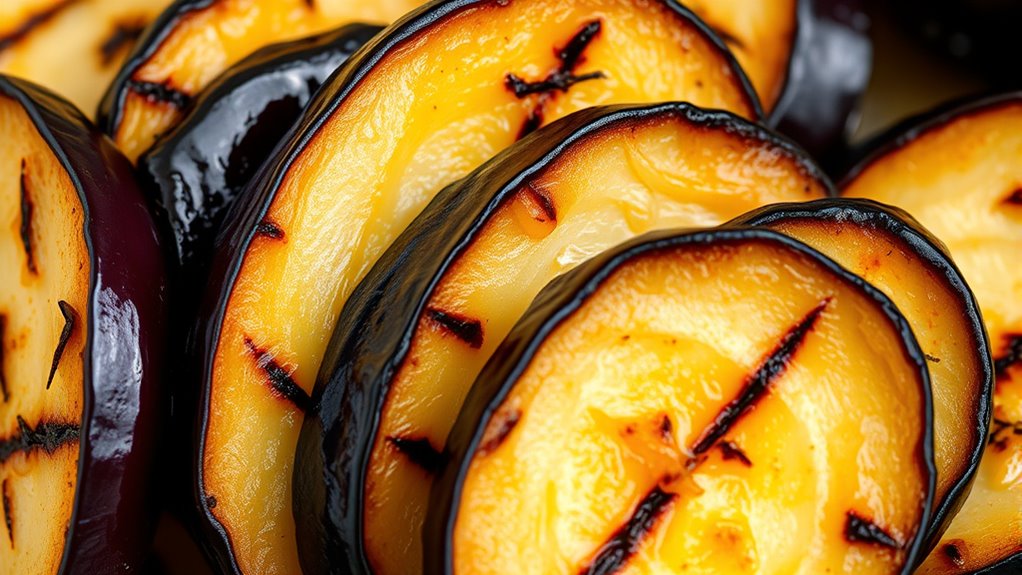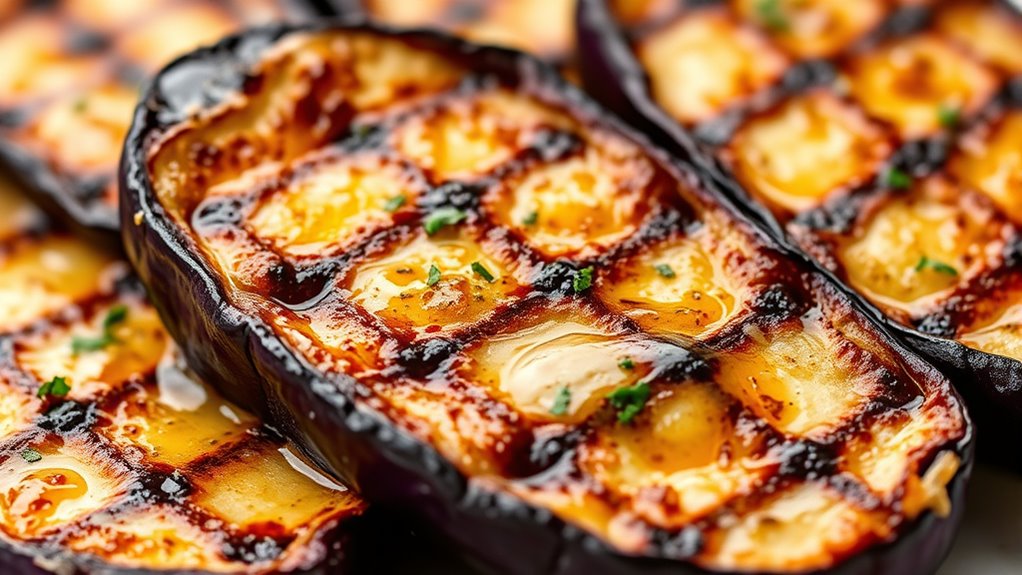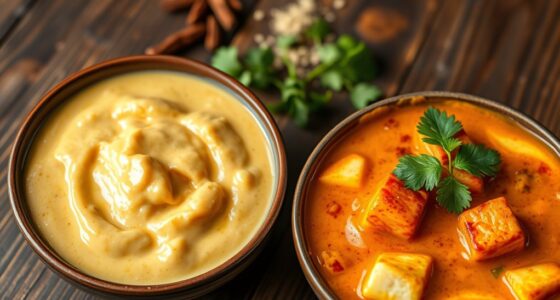To upgrade eggplant steaks with butter-basting, start by selecting firm, shiny slices around ¾ inch thick for even cooking. Salt and marinate your slices with herbs and spices, then sear in a hot skillet with high smoke point oil. Baste generously with melted garlic-infused butter during cooking to develop a crispy, golden crust while keeping the interior tender. Mastering heat control and basting techniques makes a noticeable difference — keep going to discover the full method.
Key Takeaways
- Use medium-high heat to develop a crispy, golden crust while preventing burning.
- Continuously baste with melted butter infused with garlic for even flavor and improved texture.
- Turn eggplant steaks carefully to ensure uniform searing and crust formation on all sides.
- Properly preheat the skillet or grill for consistent heat distribution, enhancing crispness.
- Maintain a balance of heat and basting timing to achieve a tender interior with a crisp, flavorful exterior.
Selecting and Preparing the Perfect Eggplant Slices

To guarantee your eggplant steaks turn out perfectly, start by choosing firm, shiny eggplants with smooth skin. Different eggplant varieties offer unique flavor profiles; for instance, globe eggplants are mild and slightly sweet, while Japanese or Chinese eggplants tend to be more delicate and less bitter. Consider your taste preferences when selecting your variety. When preparing, wash the eggplants thoroughly and cut off the stems. For even cooking, slice the eggplants into uniform steaks, about ¾ to 1 inch thick. Remove excess moisture by salting the slices lightly and letting them sit for 20-30 minutes, then pat dry. This step helps reduce bitterness and excess water, ensuring your eggplant steaks are flavorful and have a good texture during cooking. Additionally, choosing the right projector type can enhance your viewing experience if you plan to watch videos of your cooking process.
Achieving the Ideal Thickness for Steaks

To get perfect eggplant steaks, aim for a thickness of about 1/2 to 3/4 inch. This range helps guarantee they cook evenly without becoming mushy or undercooked. Adjust the thickness slightly based on your oven or grill to achieve uniform results. For added flavor and health benefits, consider using keto-friendly oils like avocado or coconut oil when cooking.
Optimal Thickness Range
Achieving the perfect thickness for eggplant steaks is essential to guarantee they cook evenly and develop the desired texture. Aim for slices between ¾ inch and 1 inch thick, which allows heat to penetrate without becoming mushy. When slicing, your knife skills matter; a sharp knife produces clean cuts that preserve the eggplant’s vibrant color and prevent bruising. Thinner slices tend to dry out and lose their structure, while thicker ones may remain undercooked inside. Consistent thickness ensures each steak cooks uniformly, especially when butter-basting. Use a ruler or a steady hand to maintain even slices, and focus on controlling your knife’s angle for smooth, precise cuts. This range strikes the right balance between tenderness and bite. Additionally, knife skills play a crucial role in achieving uniform slices, making the process easier and more effective.
Adjusting for Uniform Cooking
Maintaining consistent thickness throughout your eggplant steaks guarantees they cook evenly from edge to center. To achieve this, aim for about 3/4-inch thickness, whether you’re grilling or oven-roasting. Thicker steaks take longer to cook, risking uneven texture, while thinner ones can dry out. When using a grill versus oven, adjust your approach: grill steaks should be slightly thicker to prevent burning, while oven steaks can be thinner for quicker, even cooking. Use flavor infusion techniques like marinating or brushing with butter to enhance taste without affecting thickness. Uniform thickness ensures heat penetrates evenly, promoting consistent cooking and better flavor absorption. Regularly check the steaks’ size and shape, trimming any uneven edges for a perfect, tender result every time. Proper food safety practices, such as avoiding cross-contamination, also help ensure your steaks are cooked safely and thoroughly.
Seasoning and Marinating for Enhanced Flavor

Enhancing the flavor of eggplant steaks starts with thoughtful seasoning and marinating. You want to choose herb combinations that complement the eggplant’s natural earthiness, like basil, oregano, and thyme. Spice blends such as smoked paprika, cumin, or coriander add depth and warmth. Before cooking, brush the steaks with a marinade that includes olive oil, lemon juice, and your chosen herbs and spices. Let the eggplant sit for at least 30 minutes to absorb the flavors fully. This step guarantees each bite is flavorful and well-seasoned. Adjust the seasoning to your taste, balancing herbs and spices for a vibrant, savory profile. Proper seasoning and marinating elevate the eggplant, making every bite rich and satisfying. Regular use of Glycolic Acid can also improve skin texture and pore visibility, enhancing your overall appearance and confidence.
Choosing the Right Pan and Cooking Fat

Choosing the right pan and cooking fat is essential to getting perfectly seared eggplant steaks. A cast iron skillet is ideal because it retains heat evenly, ensuring a consistent sear without sticking. Its durability gives you a reliable surface for high-heat cooking, resulting in a beautifully caramelized crust. Alternatively, a high-quality non-stick pan works well if you prefer easier cleanup and less oil use. Use a fat with a high smoke point, like clarified butter, vegetable oil, or avocado oil, to prevent burning and promote even browning. Avoid low-smoke-point fats such as butter alone, which can burn during searing. Selecting the appropriate pan and fat sets the foundation for achieving that perfect texture and flavor in your eggplant steaks. Additionally, incorporating mindful cooking practices can enhance your meditation experience by fostering focus and presence during meal preparation.
The Art of Basting With Butter for Maximum Flavor

Once your eggplant steaks are nicely seared, the next step is to infuse them with rich flavor through basting. As you spoon melted butter over the surface, focus on creating a butter infusion that penetrates the layers of the eggplant. This process enhances flavor layering, adding depth and complexity to each bite. Keep the heat medium to prevent the butter from burning and to allow gentle absorption. Use a spoon to continuously baste, ensuring even coverage and maximizing the butter’s contact with the eggplant. This technique not only amplifies the savory notes but also helps develop a beautifully glazed exterior. With each baste, you reinforce the richness, transforming simple eggplant into a savory, flavor-packed dish. Water parks often feature seasonal events and activities that can provide inspiration for creative cooking techniques like basting.
Cooking Technique: Searing and Basting to Perfection

To achieve perfectly seared and flavorful eggplant steaks, you need to master the art of searing and basting simultaneously. Use your sautéing techniques to guarantee even contact with the hot pan, creating a beautiful caramelized crust. Keep the heat moderate to prevent burning while developing rich flavor pairing with butter and herbs. As the eggplant cooks, baste generously with melted butter, allowing the flavors to seep in and enhance tenderness. Turn the steaks carefully to ensure uniform searing on all sides. The key is to stay attentive, adjusting heat as needed, and continuously baste to create a luscious, flavorful coating. Incorporating water resistance features into your cooking setup can help maintain consistent heat and prevent moisture buildup, elevating your technique. This combination of searing and basting elevates the eggplant’s texture, giving it a savory exterior while maintaining a tender interior.
Achieving a Crispy Exterior While Maintaining Tenderness

To get a crispy exterior while keeping the eggplant tender, you need to start with proper salt prepping to draw out excess moisture. Maintaining a suitable cooking temperature ensures the outside crisps up without burning, while effective butter basting adds flavor and helps develop a golden crust. Mastering these points will elevate your eggplant steaks to perfection. Additionally, understanding the best cooking techniques can further enhance texture and flavor.
Proper Salt Prepping
Proper salt prepping is essential for achieving a crispy exterior on eggplant steaks while keeping the interior tender. When you salt the slices correctly, you enhance flavor penetration and draw out excess moisture that can make the surface soggy. Proper salt application ensures the eggplant crisps up nicely without losing tenderness inside. To maximize results, focus on evenly salting both sides and letting the slices sit for at least 30 minutes. This process helps break down cell walls and reduces bitterness. Remember, the goal is balanced seasoning that promotes crispiness without over-drying. Techniques like rinsing off excess salt afterward can prevent overly salty bites. Additionally, salting techniques can help ensure even seasoning and moisture removal. With proper salt prepping, your eggplant steaks will develop a satisfying crunch and a tender, flavorful interior.
Optimal Cooking Temperature
Achieving the perfect crispy exterior while keeping the eggplant tender depends on controlling your cooking temperature carefully. For grilling, set your grill temperature to medium-high, around 375°F to 400°F, to develop a crisp crust without burning. If you’re roasting in the oven, adjust the oven settings to 400°F, ensuring even heat distribution. Too high a temperature risks burning the outside before the inside is tender, while too low can result in limp eggplant. Keep a close eye on your heat, and consider preheating your grill or oven to guarantee consistent results. Proper temperature control allows the eggplant to caramelize and crisp up while remaining soft inside, giving you that ideal texture contrast for your butter-basted steaks.
Effective Butter Basting
Effective butter basting transforms eggplant steaks into crispy, flavorful delights without sacrificing tenderness. To achieve this, baste them with melted butter infused with garlic flavor, ensuring even coverage. Keep the heat medium-high to develop a golden, crispy crust while keeping the interior tender. Use a spoon to continuously spoon the buttery mixture over the surface, promoting uniform browning. For presentation tips, garnish with fresh herbs and a drizzle of the garlic butter for visual appeal. Be mindful of the timing—baste just enough to enhance texture without overdoing it. Properly executed, this technique elevates your eggplant steaks, adding irresistible crunch and depth of flavor. Focus on balance, and your dish will look as good as it tastes.
Serving Suggestions and Complementary Dishes

To make the most of butter-basted eggplant steaks, consider pairing them with fresh, vibrant accompaniments that enhance their rich flavor. A crisp, white wine like Sauvignon Blanc or a light, fruity red such as Pinot Noir pairs well, balancing the buttery richness. Incorporate complementary herbs like basil, thyme, or oregano to brighten each bite. Serve the steaks alongside a simple green salad, roasted vegetables, or a tangy tomato salsa to add freshness and contrast. Toasted bread or grilled polenta also make great bases, soaking up the flavorful drippings. These pairings elevate your dish, creating a well-rounded, satisfying meal. Focus on balancing the buttery, savory notes with bright, herbal, and acidic elements for the best experience.
Tips for Variations and Customizations

You can easily customize butter-basted eggplant steaks by experimenting with different herbs, spices, and toppings to suit your taste. Whether you’re aiming for a dairy-free option or vegan-friendly seasonings, there’s plenty of room for creativity. Add fresh herbs like basil or cilantro for brightness, or sprinkle smoked paprika for depth. For a spicy kick, try chili flakes or cayenne pepper. Toppings such as chopped nuts or vegan cheese can elevate the dish. You might also incorporate lemon zest or balsamic glaze for acidity and sweetness. These variations allow you to tailor the flavor profile to your preferences and dietary needs. Don’t be afraid to mix and match seasonings, ensuring each bite offers a new and exciting experience.
Frequently Asked Questions
Can Eggplant Steaks Be Made Ahead and Reheated?
Yes, you can make ahead reheating eggplant steaks, but proper storage tips are vital. Allow the steaks to cool completely, then store them in an airtight container in the fridge for up to 2 days. To reheat, use a skillet or oven to preserve their texture, avoiding microwave reheating which can make them soggy. Reheating gently ensures they stay flavorful and maintain their texture.
What’S the Best Way to Prevent Eggplant From Becoming Soggy?
Think of eggplant like a sponge—you want it to absorb flavors without becoming soggy. To prevent this, use salting techniques to draw out excess moisture before cooking. Oven roasting at high heat also helps evaporate water quickly, keeping your eggplant steaks firm. I once tried baking eggplant without salting, and they turned mushy—learning this trick made all the difference for a crisp, delicious result.
How Do I Store Leftovers Without Losing Flavor and Texture?
To store leftovers without losing flavor and texture, place them in airtight containers immediately after cooling. This helps prevent moisture loss and preserves freshness. When reheating, opt for gentle methods like using a skillet or oven rather than microwave, which can make eggplant soggy. Cover the container loosely or reheat with a bit of extra butter or oil to maintain moisture and enhance flavor.
Are There Suitable Substitutes for Butter in Dairy-Free Versions?
If you’re looking for substitutes for butter in dairy-free recipes, vegan butter works well because it mimics the richness and creaminess. Plant-based oils like coconut, olive, or avocado oil can also add flavor and moisture. You can even blend these oils with vegan butter for a similar texture. These options help you maintain the dish’s flavor and texture without using dairy, making your meal suitable for vegans or dairy-sensitive individuals.
How Can I Make Eggplant Steaks Vegan Without Sacrificing Flavor?
To make eggplant steaks vegan without sacrificing flavor, you can use vegan butter to mimic the richness of dairy-based options. Enhance the flavor with plant-based seasonings like garlic, smoked paprika, and nutritional yeast. Try marinating the eggplant in a mixture with soy sauce or miso for umami depth. Baste with vegan butter during cooking, and add fresh herbs for a burst of freshness, ensuring a delicious, plant-based result.
Conclusion
As you finish basting your eggplant steaks with butter, imagine the golden crust forming like a warm, inviting hug around each tender slice. The aroma fills the air, hinting at smoky, buttery goodness. With every bite, you’ll experience a perfect balance of crispy exterior and melt-in-your-mouth softness, creating a dish that’s both satisfying and luxurious. Enjoy this flavorful upgrade, turning simple eggplant into a stunning centerpiece that delights all your senses.










